What Is Composable Commerce?
No longer a buzz term, composable commerce represents a paradigm shift in eCommerce architecture, fundamentally redefining how businesses approach their online shopping experiences. Given the benefits, it’s no wonder.

Composable commerce is a modular approach to building your e-commerce platform using interchangeable, best-of-breed components. Instead of relying on one giant suite for everything, you compose your solution, plugging together specialized services for storefront, search, checkout, CMS, payments, etc.
This approach lets businesses and developers swap out parts, scale independently, and innovate faster to meet changing needs. It’s a strategy born from the need for greater flexibility in a rapidly evolving digital market, and it’s increasingly seen as the future of commerce.
Why does composable commerce matter? In short, it gives your team the agility to deliver better customer experiences across all channels without being handcuffed by a monolithic platform.
According to the MACH Alliance, 79% of tech leaders plan to increase composable elements in their tech stack within the next year – a huge shift signaling that companies crave the freedom to tailor their commerce systems.
Gartner even predicts that organizations adopting a composable approach will outpace competitors significantly in rolling out new features.
That's the TL; DR. Now, let’s dig deeper into what composable commerce means and how to leverage it for your business.
What Exactly Is Composable Commerce?
Composable commerce is an approach to e-commerce architecture where you pick and choose individual components (sometimes called Packaged Business Capabilities, or PBCs) and combine them into a custom platform. Each component is like an app that does one thing well – a product information manager (PIM), a search engine, a CMS for content, or a payment service. These components communicate through APIs to work together as one system.
Think of it like building your dream team of services. In a traditional all-in-one platform, you get a “good enough” version of each feature from a single vendor. In contrast, composable commerce lets you handpick the MVPs: maybe you use Stripe for payments, Algolia for search, Crystallize for your backend commerce service, Bloomreach for product discovery, and so on. The result is an e-commerce stack perfectly tailored to your business needs.
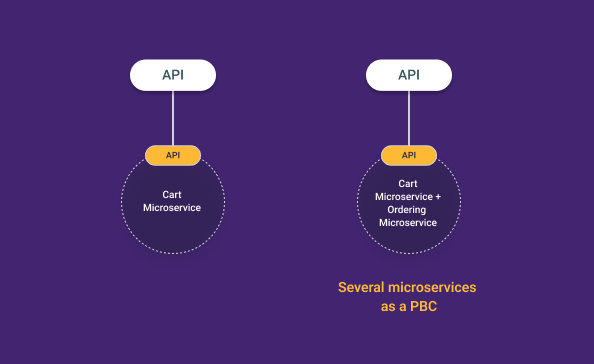
To illustrate, imagine the difference between using a Swiss Army knife versus a toolbox. A monolithic platform is the Swiss Army knife – one object with many attached tools; it’s convenient, but each tool is limited. Composable commerce is like having a full toolbox – you select the best hammer, screwdriver, and wrench for the job. It might take more effort to assemble, but each tool is high-quality, and you can replace one without affecting the others. This philosophy is built on modern principles often summarized as MACH: Microservices, API-first, Cloud-native, and Headless – all of which enable components to remain independent yet interoperable.
Crystallize’s architecture, for instance, embraces this modular philosophy. You get a decoupled frontend and a set of microservice APIs that handle specific commerce functions (product inventory, orders, etc.), which can integrate with other specialized services. The diagram below shows how a composable setup separates concerns:
In a composable commerce architecture, a decoupled frontend interacts with various backend microservices and third-party systems (like ERP, PIM, payment, and marketing tools) through APIs. This modular design allows each system piece to be developed, scaled, and maintained independently, rather than tied into one monolithic codebase.
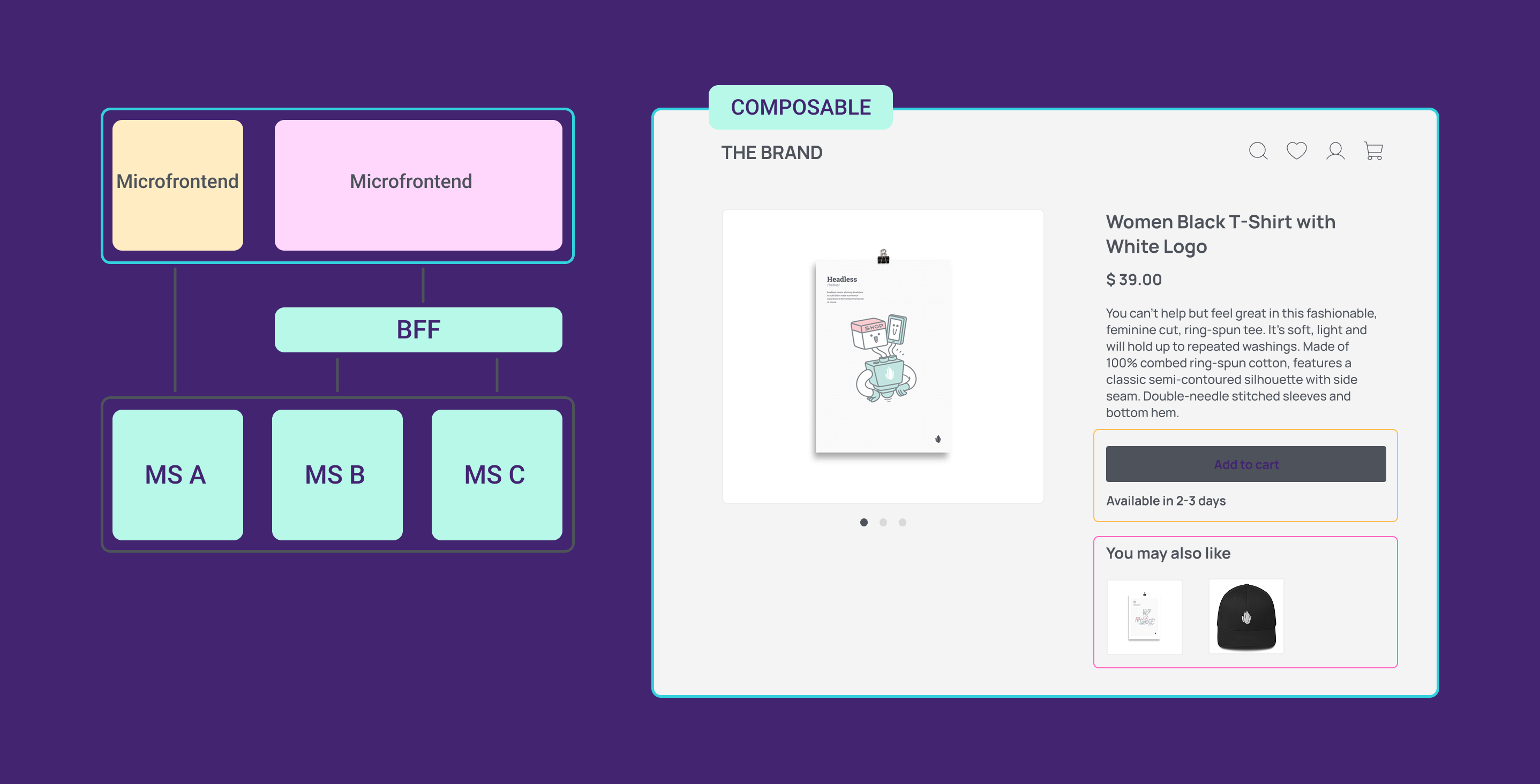
By breaking the platform into Lego-like blocks, composable commerce extends the idea of headless commerce. Headless commerce decouples only the frontend storefront from the backend, allowing you to change the user interface without touching the engine. Composable goes a step further – every engine part can be its module. You’re not just decoupling the head; you’re decoupling everything. This means businesses can update or innovate in one area (say, search or pricing logic) without risking the stability of other parts.
Composable commerce vs. traditional commerce: What’s the difference?
Let’s compare composable commerce vs. traditional (monolithic) commerce vs. headless to better grasp the value of composable commerce.
Traditional Monolithic Commerce. One provider offers an all-in-one platform that includes your CMS, product catalog, checkout, analytics, etc., in one package. While convenient initially, it’s the “jack of all trades, master of none” scenario. Changing or upgrading any element (say, you want a better search tool) is difficult because everything is tightly coupled. These systems can evolve slowly – you often have to wait for the vendor’s next release to get new features, and custom development is cumbersome. Many legacy eCommerce platforms (Magento, SAP Hybris, Salesforce Commerce Cloud) fall in this category.
Headless Commerce. This approach decouples the frontend presentation layer from the backend. You might keep the monolithic backend for commerce logic, but build a custom frontend (website/app) that talks to it via APIs. Headless gives more flexibility in designing user experiences – your team can iterate on UI/UX without backend constraints. However, you’re still tied to the single backend vendor for all commerce features. If that backend doesn’t support a new capability or integration you want, you hit a wall (or have to jury-rig it).
Composable Commerce. This is a modular, API-driven architecture where each major function is a separate component (which could be headless). The frontend is decoupled, and the backend is split into microservices or SaaS offerings focused on specific domains (product catalog, cart, checkout, search, content, etc.). For example, your “storefront” might consume APIs from five or six services that collectively replace a monolith. Unlike a pure monolith, you can upgrade or swap any services individually. Unlike just headless, you are not relying on one backend platform’s capabilities – you can always integrate another service to extend functionality. This granular control is what gives composable commerce its power.
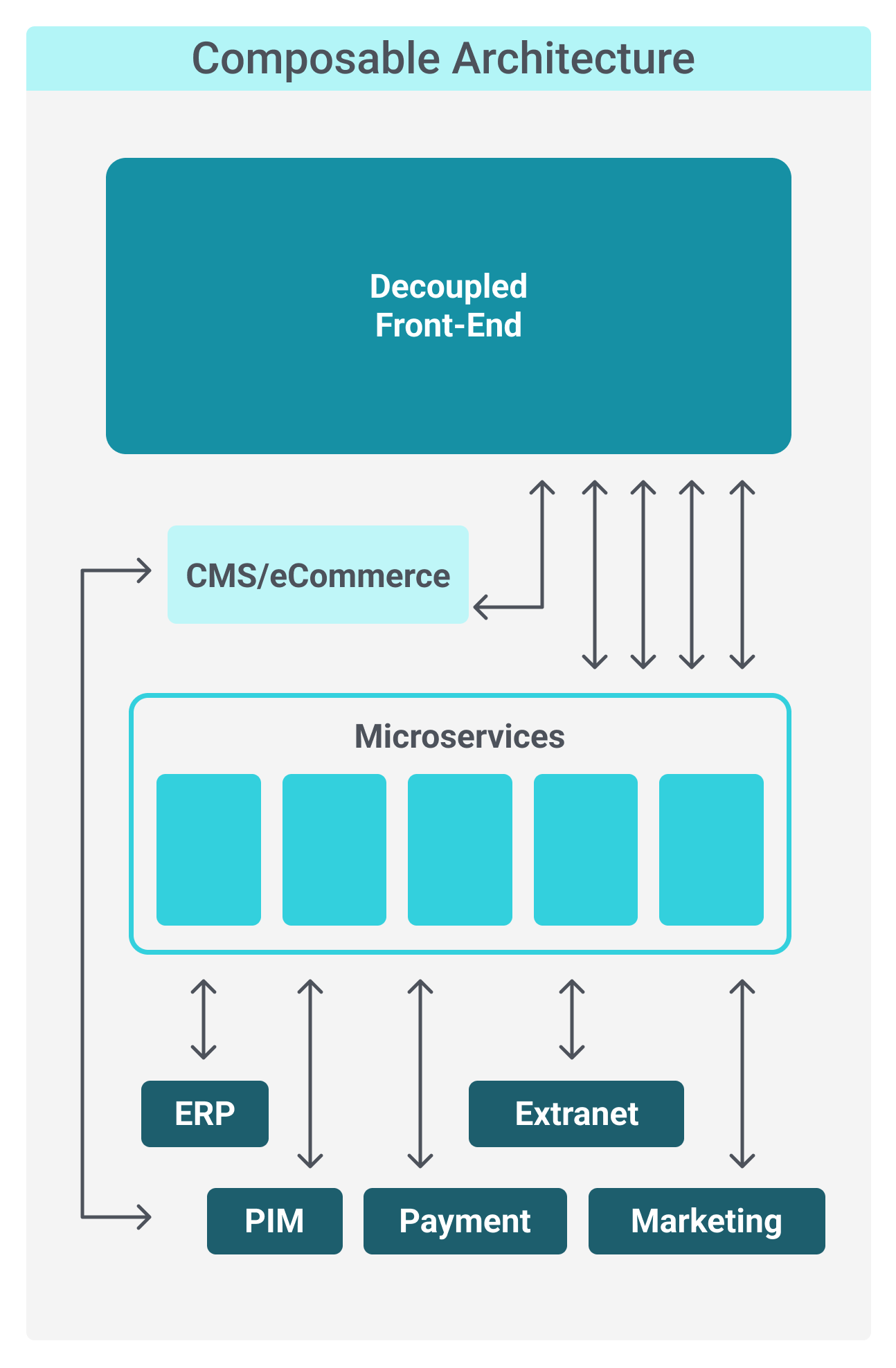
Another way to look at it is that Monolithic is like a single smartphone that does everything; headless is plugging that phone into different screens, and composable is mixing and matching many specialized gadgets. Integration is the game's name with composable commerce – everything talks through APIs and events. It requires more initial planning, but yields a solution tailored to your business.
What Are the Benefits of Composable Commerce?
Why are so many companies moving toward composable commerce?
Agility and Faster Time-to-Market. Need to launch a new feature or enter a new channel? Composable architectures let you do it in a fraction of the time it would take on a monolithic platform. Teams can work on different components in parallel and deploy independently. This agility is crucial as digital commerce moves quickly. Studies show that even a 100-millisecond improvement in page load can boost conversion rates by 8.4%, so the ability to iterate rapidly on performance and features has a direct business impact.
Flexibility and Customization. Every business is unique, and composable commerce embraces that. With a composable approach, you’re not constrained by a fixed feature set – you can craft the experience you want, picking best-in-class solutions for each need. For example, you might integrate a bespoke recommendation engine if you run an apparel store focused on personalization. Or you could choose a translation/localization service that plugs into your product information if you operate globally. This modular approach means your store can truly stand out from cookie-cutter implementations.
Scalability and Performance. Because it’s cloud-based and uses microservices, composable commerce lets you independently scale each part. So, when things get busy, like on Black Friday, you can boost checkout and order systems without touching everything else. This keeps things running smoothly and saves money. Plus, it works with modern front-end tech and CDNs to deliver super-fast web pages worldwide. A quick and reliable website means happier customers and better handling of those big surges in traffic.
Omnichannel Readiness. Today’s customers might discover your product on a mobile app, complete the purchase on a desktop website, and later interact via a smart speaker or in-store kiosk. Composable commerce makes omnichannel orchestration much easier. Because everything is driven by APIs, the same backend services (product info, cart, order) can feed into any frontend or device. For example, retailers embracing omnichannel have seen significantly higher customer lifetime value (Target’s omnichannel customers spend 4x more than single-channel shoppers). A composable stack is well-suited to capitalize on this by delivering a seamless experience across channels.
Reduced Vendor Lock-In. With a traditional single-vendor suite, you’re often stuck with whatever that vendor provides, even if some components lag behind the market. Composable commerce flips that dynamic. For example, if you’re unhappy with your current search service’s relevance, you can swap it out for a new one without rebuilding your whole platform. This keeps your technology stack future-proof and adaptable.
Empowered Teams & Innovation. Simply put, with a composable approach, your tech team isn’t stuck wrangling an old enterprise commerce or CMS – they’re free to use the best tools for the job, which fosters a culture of innovation.
Challenges and Considerations of the Composable Approach
Composable commerce isn’t a silver bullet – it comes with its own set of challenges. It’s important to be aware of these trade-offs.
Increased Complexity. Breaking things into many pieces introduces complexity in design and management. You’ll be dealing with multiple platforms or services instead of one. There are many integrations to maintain, which means more potential points of failure. Monitoring and debugging a distributed system is inherently more complex than working with a single application.
Integration Overhead. Those APIs connecting everything need to be well-designed and reliable. You must ensure that data flows correctly between your inventory system and your frontend, or between your CRM and order management. If each component has its data model, you must implement translation or middleware to make them work in concert. This is doable, but it’s an added layer of work that doesn’t exist in a pre-integrated monolith. Interoperability testing and maintenance become ongoing tasks.
Technical Expertise Required. Adopting composable commerce means your team (or solution partners) needs strong technical maturity. You’ll likely be using modern DevOps practices, cloud infrastructure, containerization (Docker/Kubernetes), frontend frameworks, and CI/CD automation to manage all these microservices. If your team doesn’t have experience in these areas, there will be a learning curve. Gartner and others have cautioned that fully composable commerce is unsuited for digitally immature organizations and often requires experienced (and sometimes expensive) developers to implement and run.
Initial Cost and Effort. While composable commerce can reduce costs long-term by letting you pay only for what you need, the upfront cost and effort can be higher. You may need to license multiple SaaS products or build custom microservices to cover all your commerce capabilities. There’s also an initial project overhead to integrate and configure everything. In contrast, a monolithic platform might be relatively plug-and-play out of the box for basic scenarios. Essentially, composable commerce trades some upfront complexity and cost for greater flexibility.
Vendor Management. No vendor lock-in, but you will manage relationships with several vendors instead of one. This means multiple support contacts, SLAs, contracts, and possibly differing update cycles. Coordinating changes can be challenging – e.g., if one API changes its version, you need to make sure your other systems adapt.
Despite these challenges, the trend is clearly toward composable solutions. The key is approaching it strategically – weighing and preparing for these considerations, rather than diving in blindly because it’s buzzworthy.
Sometimes, a hybrid approach can work: start with a mostly monolithic platform but replace one component at a time with a composable service (such as adopting a headless CMS first, then a third-party search, and so on). This incremental path lets you build confidence and capability as you go.
Is Composable Commerce Right for You?
For many businesses, composable commerce is the future, but is it the present for yours? Here are some factors to consider when deciding if this approach suits your situation:
1. Business Complexity and Scale: A complete, composable architecture might be overkill initially if you run a simple online store with a small catalog and straightforward operations. A solid all-in-one platform could cover your needs without the overhead. On the other hand, if you’re a medium to large retailer or a fast-growing brand pushing into new channels and markets, the flexibility of composable commerce can be a game-changer. High complexity (multiple product lines, multiple regions, various customer touchpoints) often tips the scales toward a composable solution that can adapt and scale with you.
2. Need for Differentiation: Ask yourself how important it is for your customer experience to stand out. If you’re in a commoditized market and compete on experience and innovation, being able to tailor every aspect of your storefront is critical. Composable commerce shines here – you can implement unique features or niche third-party services that your competitors (stuck on templated platforms) simply can’t. If, instead, you are comfortable with a standard feature set and don’t feel constrained by your current platform, the urgency to go composable might be lower.
3. Technical Resources: Do you have the technical team (in-house or outsourced) to support a composable architecture? This includes developers familiar with API integrations, cloud DevOps for microservices, frameworks, and perhaps solution architects to design the overall system. If you have a strong tech team or a reliable tech partner, you will find it much easier to succeed with composable commerce.
4. Budget and ROI Outlook: Composable commerce often means a different cost structure. You’ll be paying for multiple SaaS subscriptions or development efforts, which can add up. However, it can also optimize cost in the long run by letting you drop unused services or choose cost-efficient providers for each part. Ensure you map out the ROI – for example, will the increased conversion or faster time to market pay back the investment in a better search or personalization service?
5. Future Roadmap: Consider where you want to be in 2, 3, and 5 years. Even if you don’t go fully composable today, the tech landscape is heading that way. Nearly every major commerce platform is evolving to offer more integration capabilities and modular features. It might be wise to start laying the groundwork if you think you’ll eventually need the flexibility (and most growing businesses will). That could mean choosing platforms now that are composable-friendly – ones that allow headless use or easy integration – so you can expand modularly and future-proof your business for a later complete transition.
Composable commerce is most suitable for growth-oriented, innovation-driven organizations with the resources to handle a modular system. It’s not an all-or-nothing decision; you can adopt composable principles step by step.
In all honesty, for many businesses, the question is WHEN to go composable, rather than IF.
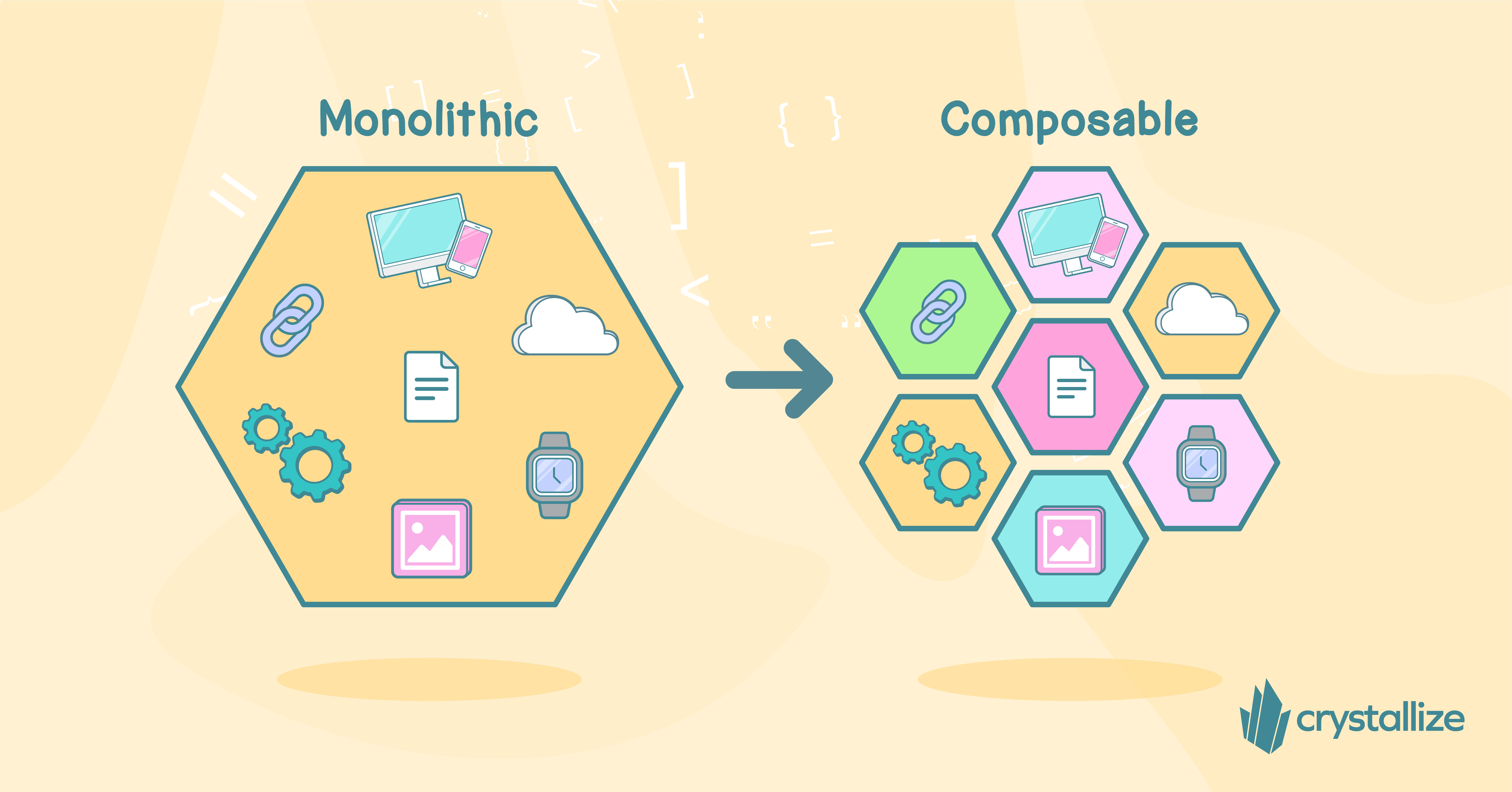
How to Get Started with Composable Commerce?
If you’ve decided to embrace composable commerce (or even just explore it), it helps to have a roadmap for implementation. While it largely depends on the tech involved in general, there are a few steps you should take to get started.
Step 1 - Identify Your Core Domains. Break down your e-commerce functionality into its main domains or business capabilities. Common ones include: product information management, commerce functionality, content management (CMS), search, pricing/promotion engine, shopping cart/checkout, order management, customer account management, etc. This domain mapping gives you a blueprint of what pieces you’ll need in your composable stack.
Step 2 - Evaluate Best-of-Breed Solutions. For each domain, research the leading solutions. You might fulfill some domains with custom-built microservices (especially if it’s a niche requirement or core to your IP), while you’ll fulfill others with SaaS/PaaS products.
Tip: Check if the vendor is MACH-certified or advertises “headless” or “API-first” – those are good signs they play well in a composable architecture.
Step 3 - Design the Integration Architecture. Decide how these components will talk to each other. Will you have a central orchestrator or middleware (like an API gateway or a backend-for-frontend) that aggregates multiple services for the frontend? Will you use an event bus or queue for specific processes (e.g., an order placed event triggers notifications to ERP, CRM, etc.)? Defining a clear integration pattern is crucial. Document the data flow between services – e.g., when a customer checks out, what services are invoked (inventory service, payment gateway, order service, confirmation email service)? Ensure each integration point has a defined API contract. This is also the stage to plan for data consistency (how will data be synced across services) and security (authentication/authorization between services).
Step 4 - Implement Incrementally. You don’t have to do everything at once. You might start by making your frontend headless (decoupling from your old platform) and gradually plugging it into a new set of APIs. Or you might replace one part of your existing platform at a time. Remember, each phase should deliver immediate benefits (better site search, faster content updates, etc.) to justify the effort and build momentum.
Step 5 - Leverage Cloud and DevOps Tools. Use containerization (Docker) and orchestration (Kubernetes) if you’re building your services so that each component can be deployed and scaled independently. Implement CI/CD pipelines for each microservice or integration so you can deploy updates continuously. Set up monitoring and logging for a distributed system – tools like Prometheus, Grafana, or New Relic can help track the health of each service. Automation is your friend when managing multiple parts. Also, establish a practice for versioning your APIs and having backward compatibility when possible, so you can update services without breaking others.
Step 6 - Test Thoroughly and Monitor. In addition to unit tests for each component, invest in integration and end-to-end testing to ensure the user journey works when all pieces connect. Once live, monitor individual service performance and the end-to-end latency of critical flows (e.g., time from clicking “Buy” to order confirmation). This will help you quickly identify if one component is slowing things down or causing errors. Having robust monitoring will also give you confidence to iterate quickly, because you’ll catch issues early.
Step 7 - Train and Enable Your Team. Ensure developers are trained on the new tools and paradigms. Also, educate non-technical stakeholders about the changes – for instance, your content editors should know if they have a new PIM or CMS in place, your marketers should know how promotions are managed in the new commerce system, etc.
🤔Crystallize and Composable Commerce.

Crystallize was purpose-built to allow you to manage your products and rich marketing content and capture orders from a single place.
Targeted towards frontend developers with fast and easy-to-use APIs and editorial users with a beautiful and efficient editorial UI to manage your products and marketing content. We were set up to reimagine eCommerce and provide clients with polished compatibility with industry-leading microservices and expert consultation.
To do that successfully, we’ve built a fast GraphQL Service API that acts as a middleware service and allows you to connect your microservices easily. To pick and choose (and remove) services depending on your needs. Little did we know that it was a composable way of thinking.
Today, you might be using Auth0 for authentication, but your plans involve using Netlify as a hosting platform, so opting out of Netlify Identity is only natural. With a composable setup, the change is fairly simple.
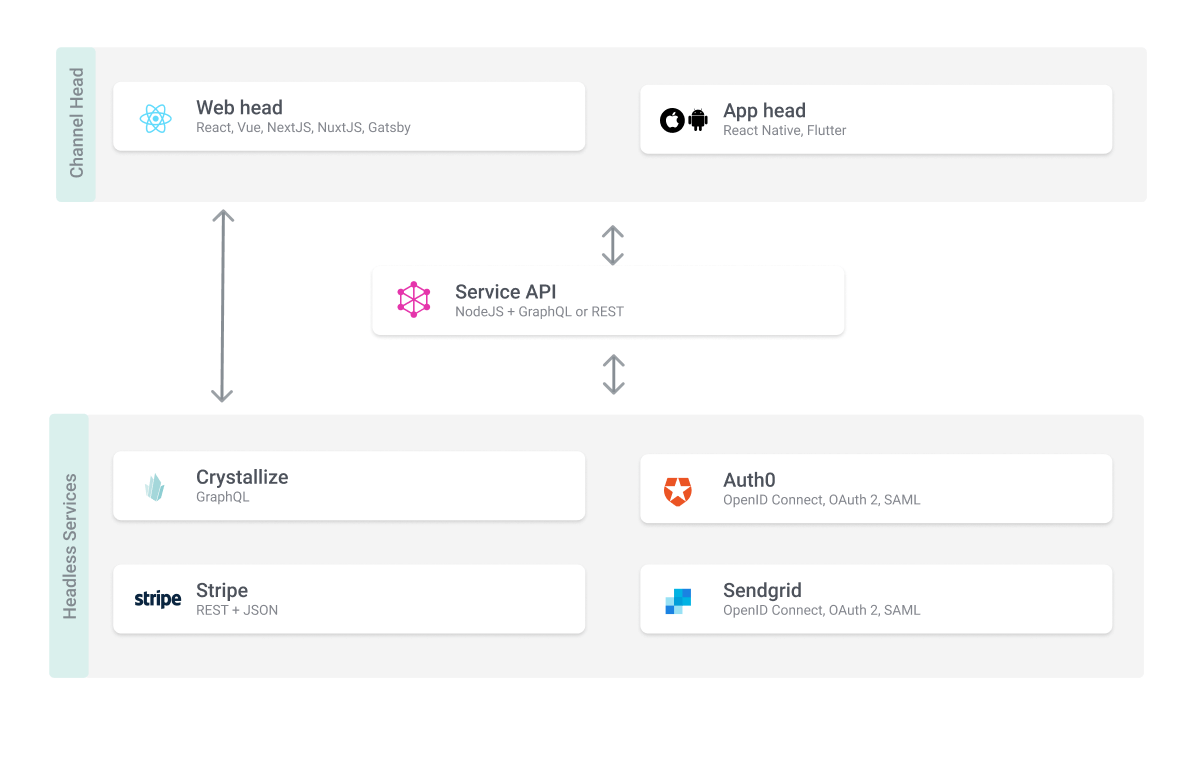
Embracing the Future of Commerce
Switching to composable commerce means ditching the all-in-one platforms for a building block approach, giving businesses more flexibility and the power to customize everything. This means you can quickly jump on market changes and customer demands and roll out new features and campaigns without hitting tech roadblocks.
For developers, it's like playing with all the cool new toys, building super-optimized systems.
Sure, moving to composable takes some serious planning and skill, as well as getting it right. Still, the payoff is huge: better customer experiences, things running smoother, and your business can grow and adapt much faster.
If a business wants to stand out and have tech ready for anything, composable commerce is a smart move. You can start small, learn as you go, and team up with the right people and tools to make it work. Lots of big names in retail and brands are already making the switch.
What are you waiting for?
START building for FREE with Crystallize or schedule a 1-on-1 demo so we can show you how to scale your business effortlessly with the composable commerce approach.
🐰Follow the White Rabbit

Headless Architecture: Benefits, Best Practices, Challenges, and Use Cases
Headless architecture is a modern approach to web development in which the front end (the "head") is decoupled from the back end.

Comprehensive Guide to Modern eCommerce Web Development: Trends, Approaches, and Best Practices
Explore the latest trends, development approaches, and best practices to build high-performing online stores in modern e-commerce web development.

Build Faster, Smarter, Better: The Ultimate Next.js eCommerce Boilerplate
The Crystallize open-source starter kit provides developers with a robust boilerplate to quickly build modern, scalable eCommerce storefronts using the latest front-end technologies and best practices in performance, content modeling, and user experience.
